Connecting a Spring Boot Application to Yugabyte Cloud and Deploying It to Kubernetes on minikube
- Published on
- • 7 mins read
- Written by

- Name
- Gavin Johnson
- @thtmnisamnstr
This post was originally published on Yugabyte’s blog.
Spring Boot is one of the most popular frameworks for building cloud native applications. It makes configuring an application easy and offers tons of starters to get you off the ground quickly. Each Spring Boot application is stand-alone and self-contained, which makes them easy to deploy in a distributed fashion – to containers or, even better, on Kubernetes.
Yugabyte Cloud is a perfect match for Spring Boot applications, especially ones made highly available with Kubernetes. Yugabyte Cloud gives you a PostgreSQL-compatible database that is resilient and scalable, just like the applications you run on k8s. You can scale your YugabyteDB cluster out (or in) with just a few clicks. So you can spend less time worrying about running your database and more time focused on building better software. It’s cloud native SQL for cloud native applications. Sign up for Yugabyte Cloud today.
Walkthrough
In this post, we’ll walk you through connecting a Spring Boot application to Yugabyte Cloud and deploying it on minikube. You can view our walkthrough on connecting a Spring Boot application to Yugabyte Cloud and deploying it on Kubernetes via Amazon Elastic Kubernetes Service (EKS) here and via Google Kubernetes Engine (GKE) here. We’ll be using a slightly updated version of the popular Spring Boot PetClinic sample application that has a profile making it compatible with YugabyteDB. The repository for this is at https://github.com/yugabyte/spring-petclinic.
In this walkthrough, you will:
- Create a free Yugabyte Cloud account and database cluster
- Download the Spring Boot PetClinic sample application and connect it to Yugabyte Cloud
- Containerize the Spring Boot PetClinic sample application
- Start minikube
- Deploy the Spring Boot PetClinic sample application image to minikube
Prerequisites
Note: Anything in brackets [ ] needs to be replaced with information from your deployment.
Create a free Yugabyte Cloud account and database cluster
Go to https://cloud.yugabyte.com/signup and sign up for a Yugabyte Cloud account. After you’ve signed up and verified your email address, go to https://cloud.yugabyte.com/login and sign in.
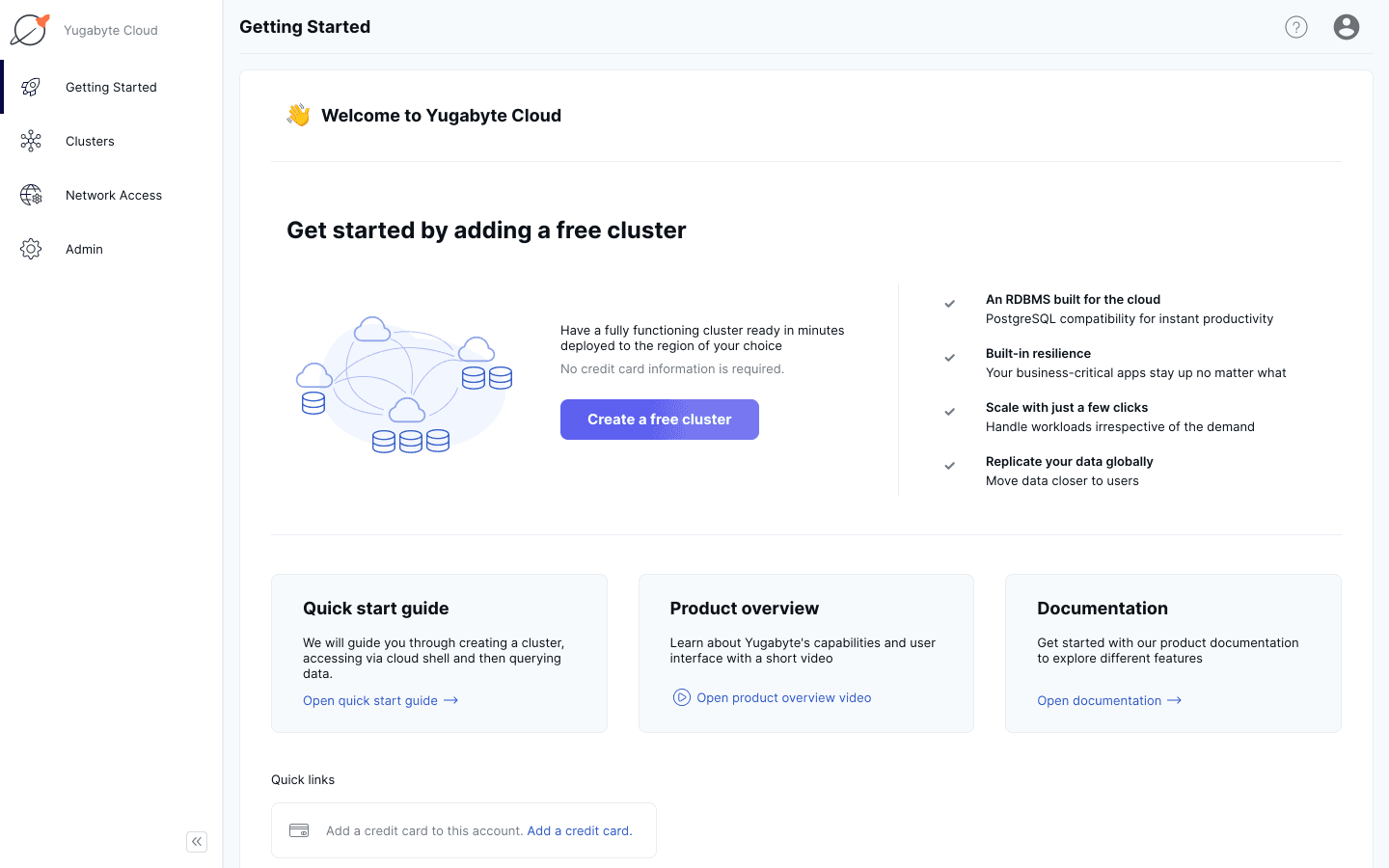
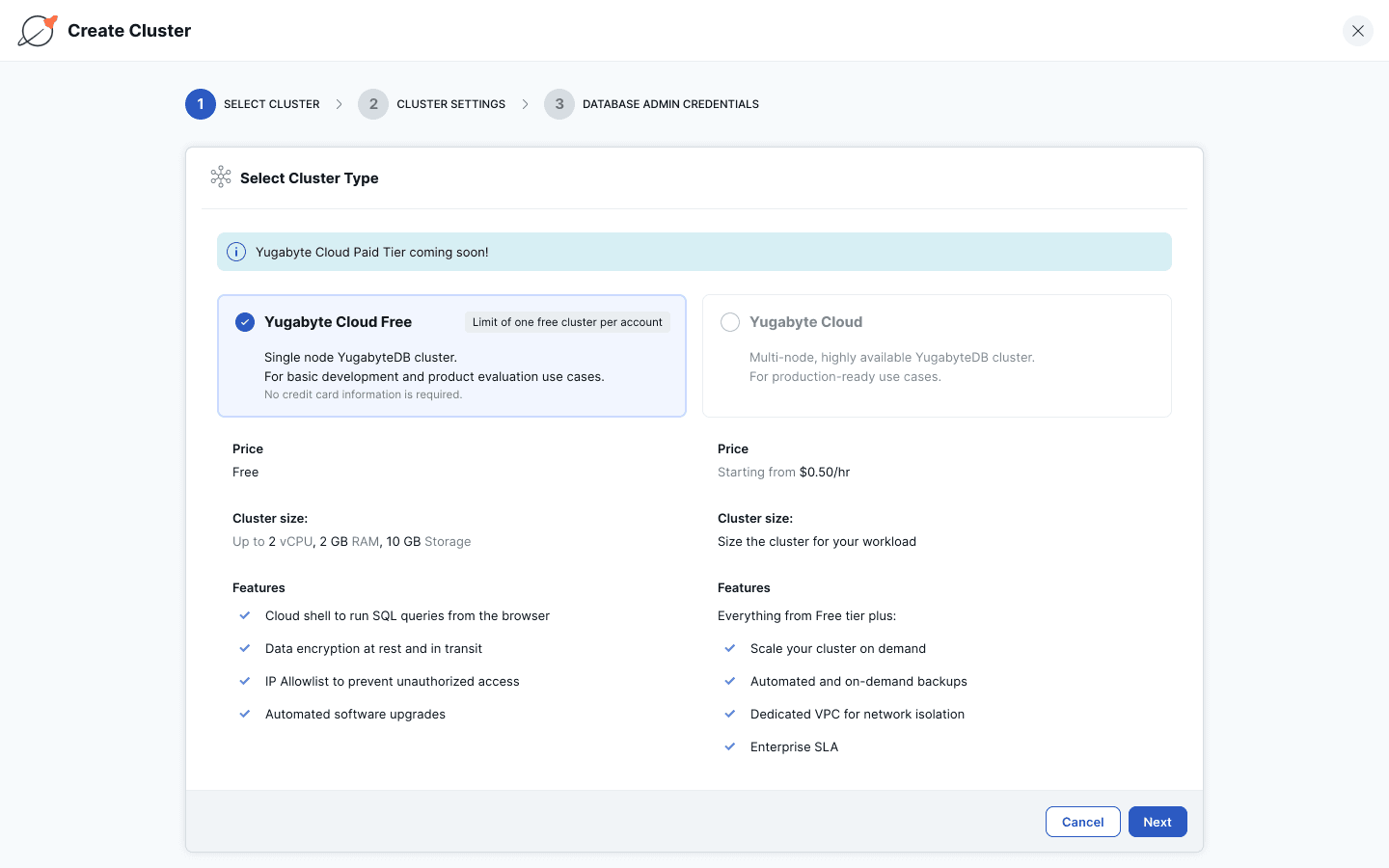
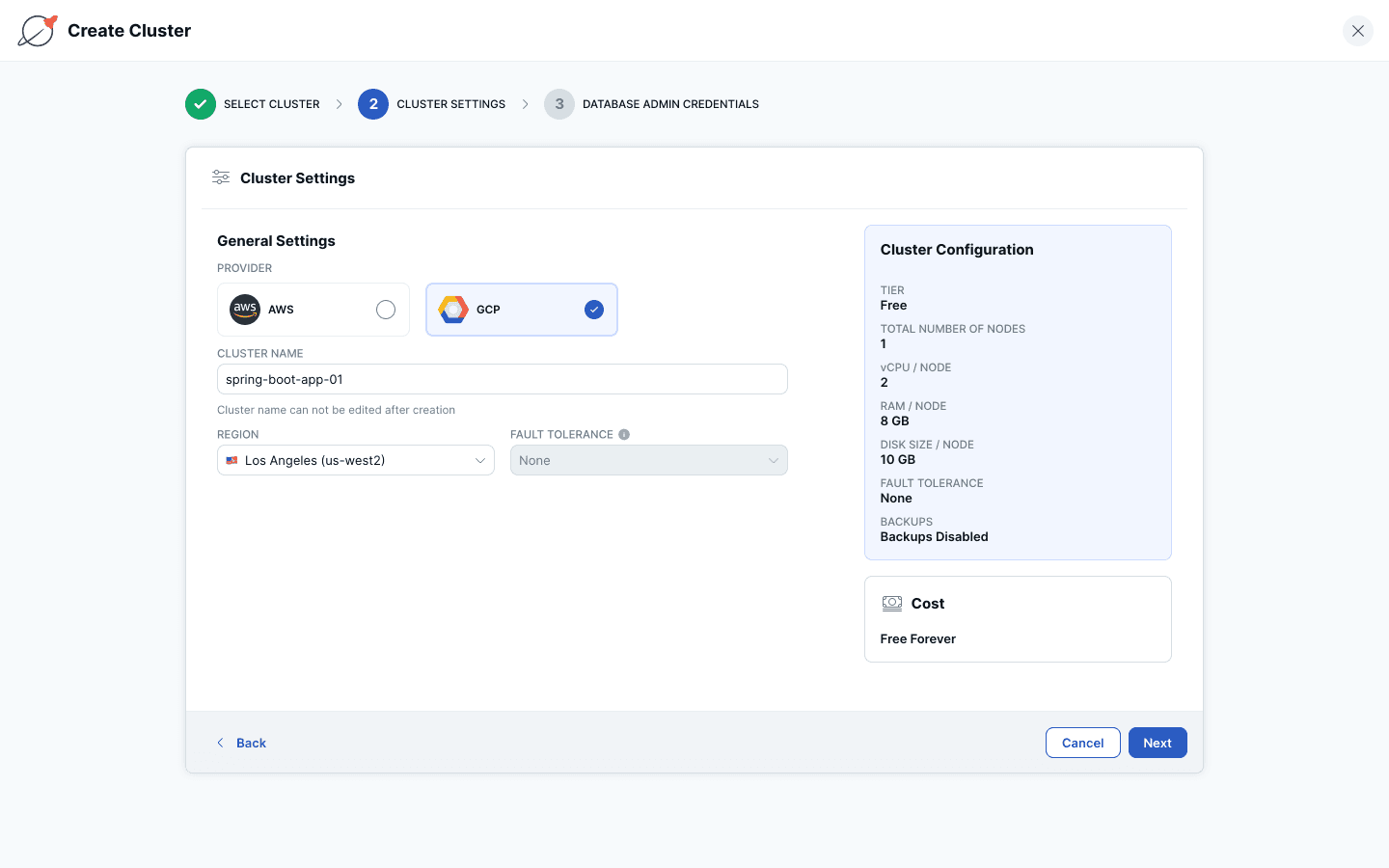
Copy the default admin credentials by clicking the Copy Credentials link. Then check the “I have copied the admin credentials” checkbox and click the Create Cluster button.
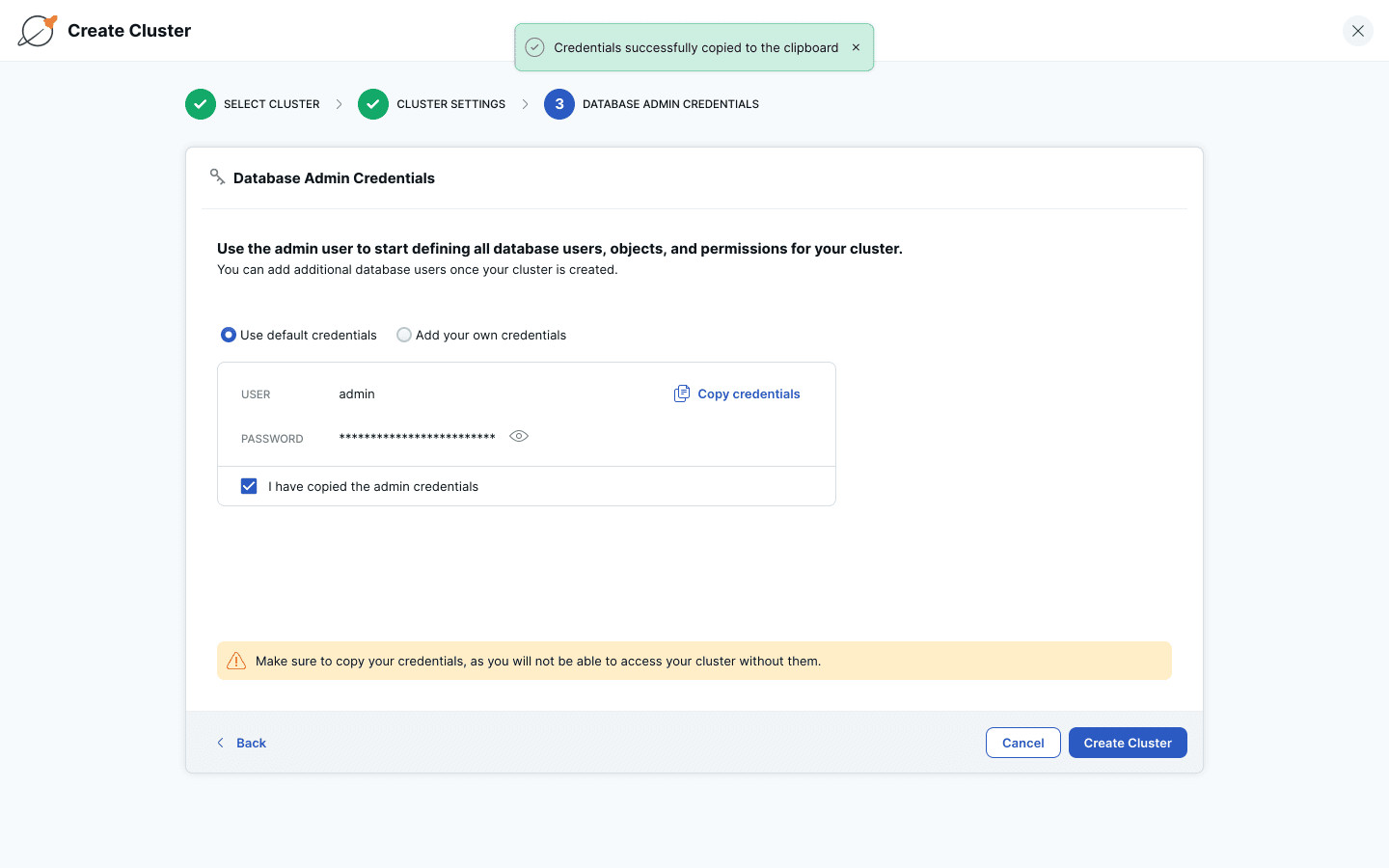
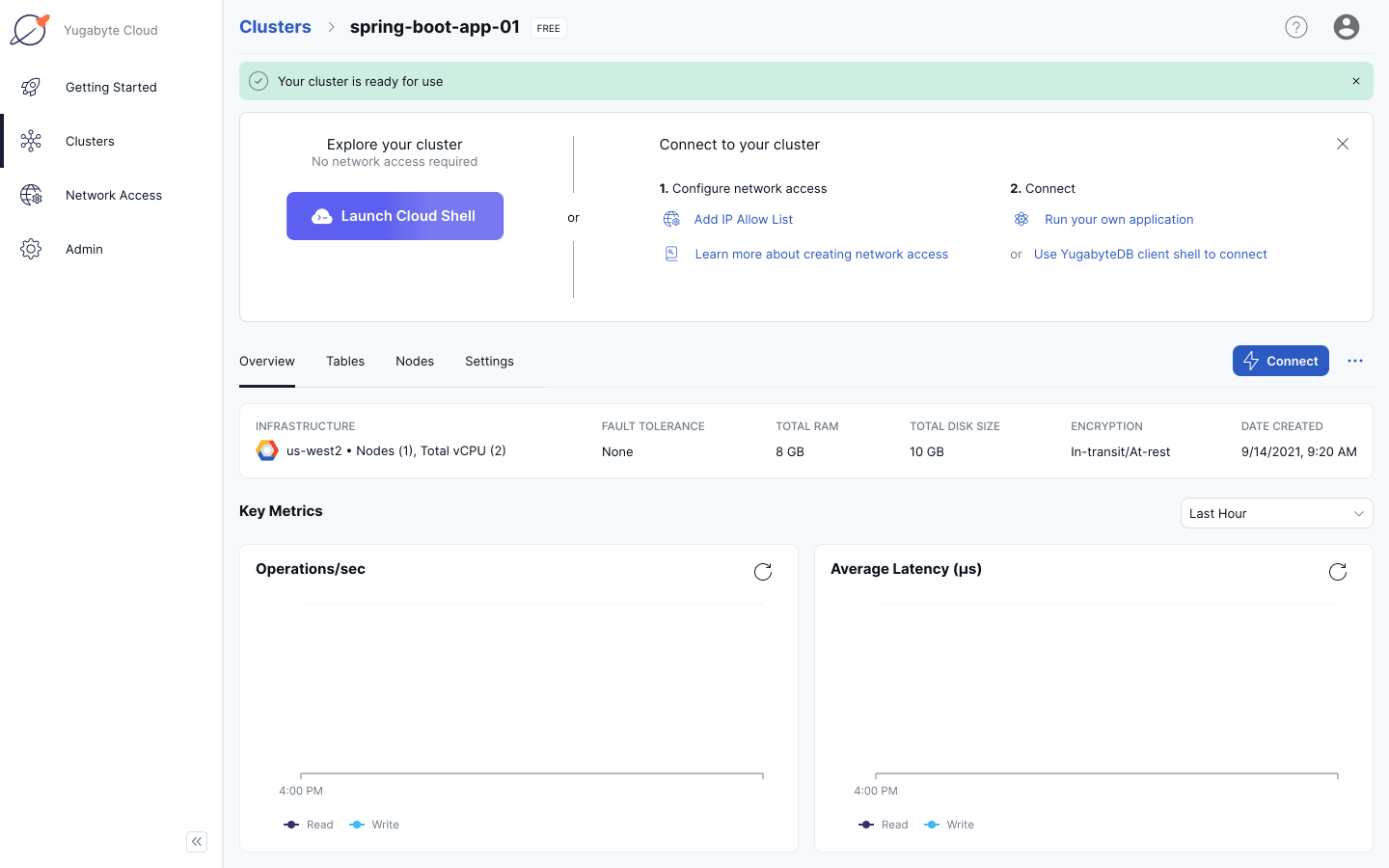
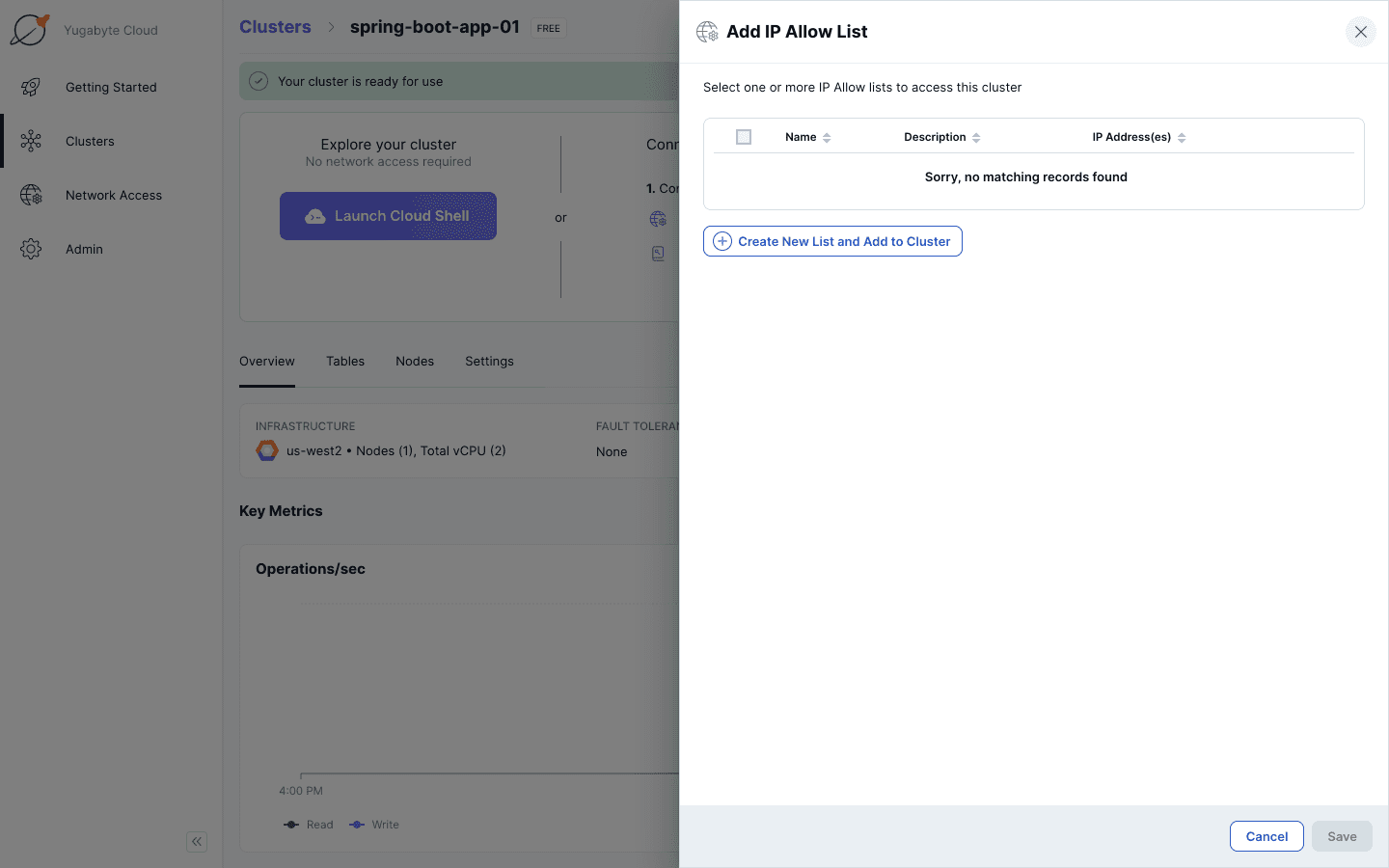
In the Name text box, enter “all-ips”. In the IP Address(es) or Range text box, enter “0.0.0.0/0”. Click the Save button. This will allow traffic from all IP addresses to your cluster.
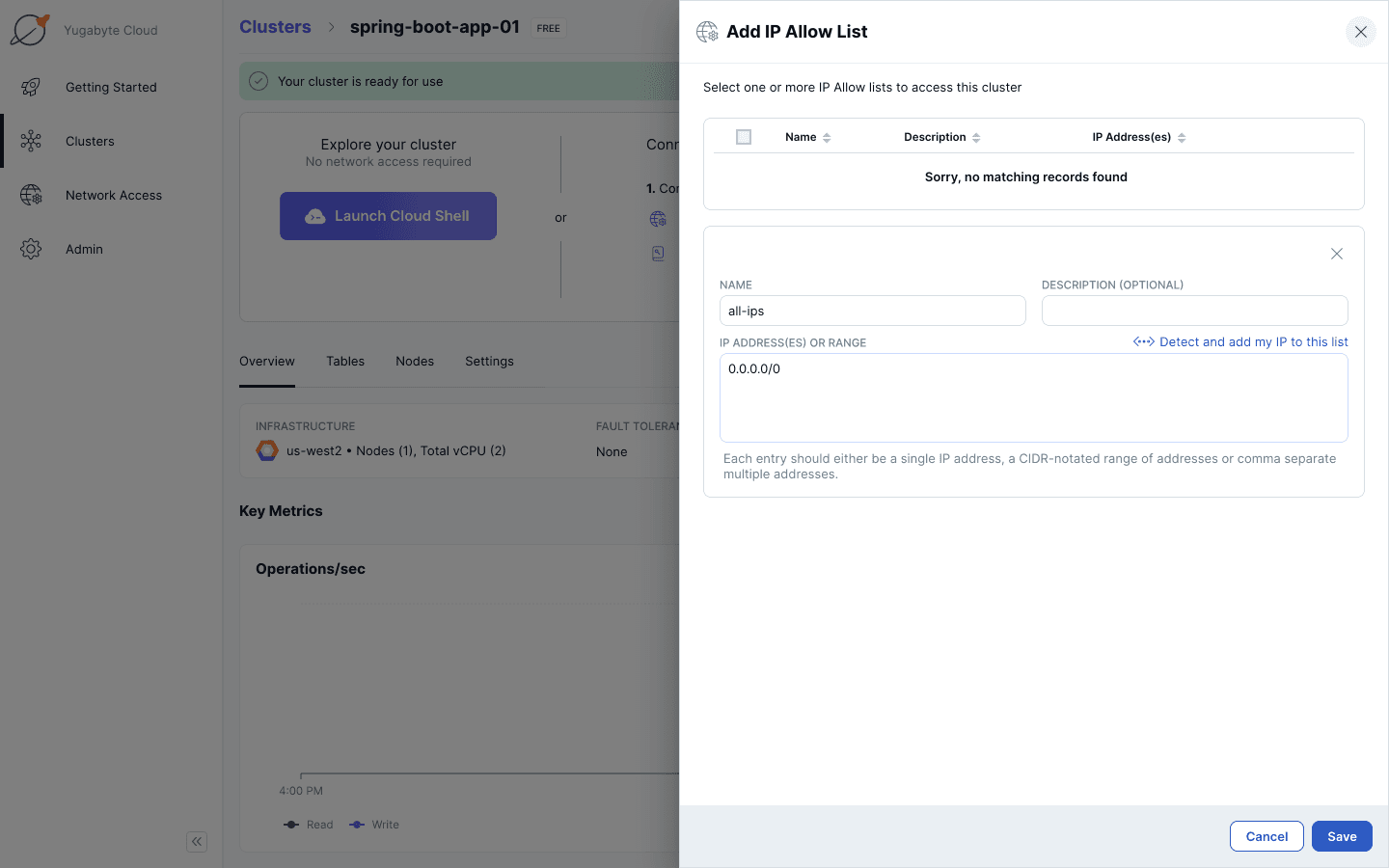
Your cluster is now created in Yugabyte Cloud and is accessible to all IP addresses. Leave this page open, as you’ll be accessing the Cloud Shell later to create an application database and user.
Download the Spring Boot PetClinic sample application and connect it to Yugabyte Cloud
Note: Instructions for how to connect this application to YugabyteDB are in spring-petclinic/src/main/resources/db/yugabytedb/petclinic_db_setup_yugabytedb.md from the repo you clone below.
On your computer from terminal, clone the Spring Boot PetClinic sample application:
git clone https://github.com/yugabyte/spring-petclinic.git.$ git clone https://github.com/yugabyte/spring-petclinic.git Cloning into 'spring-petclinic'... remote: Enumerating objects: 8616, done. remote: Counting objects: 100% (18/18), done. remote: Compressing objects: 100% (18/18), done. remote: Total 8616 (delta 1), reused 13 (delta 0), pack-reused 8598 Receiving objects: 100% (8616/8616), 7.29 MiB | 19.03 MiB/s, done. Resolving deltas: 100% (3268/3268), done.cd spring-petclinic.Copy the contents of
spring-petclinic/src/main/resources/db/yugabytedb/user.sql.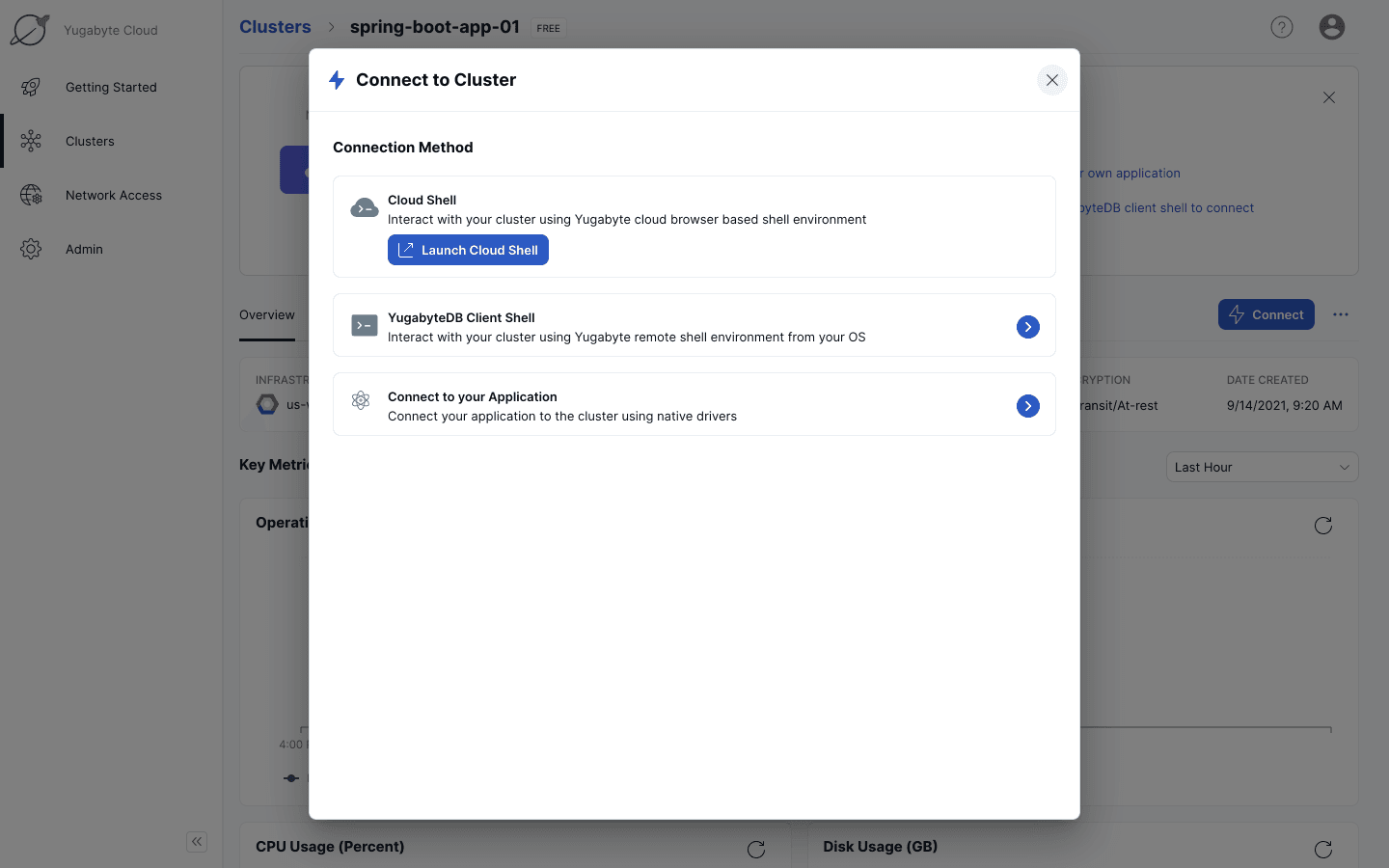
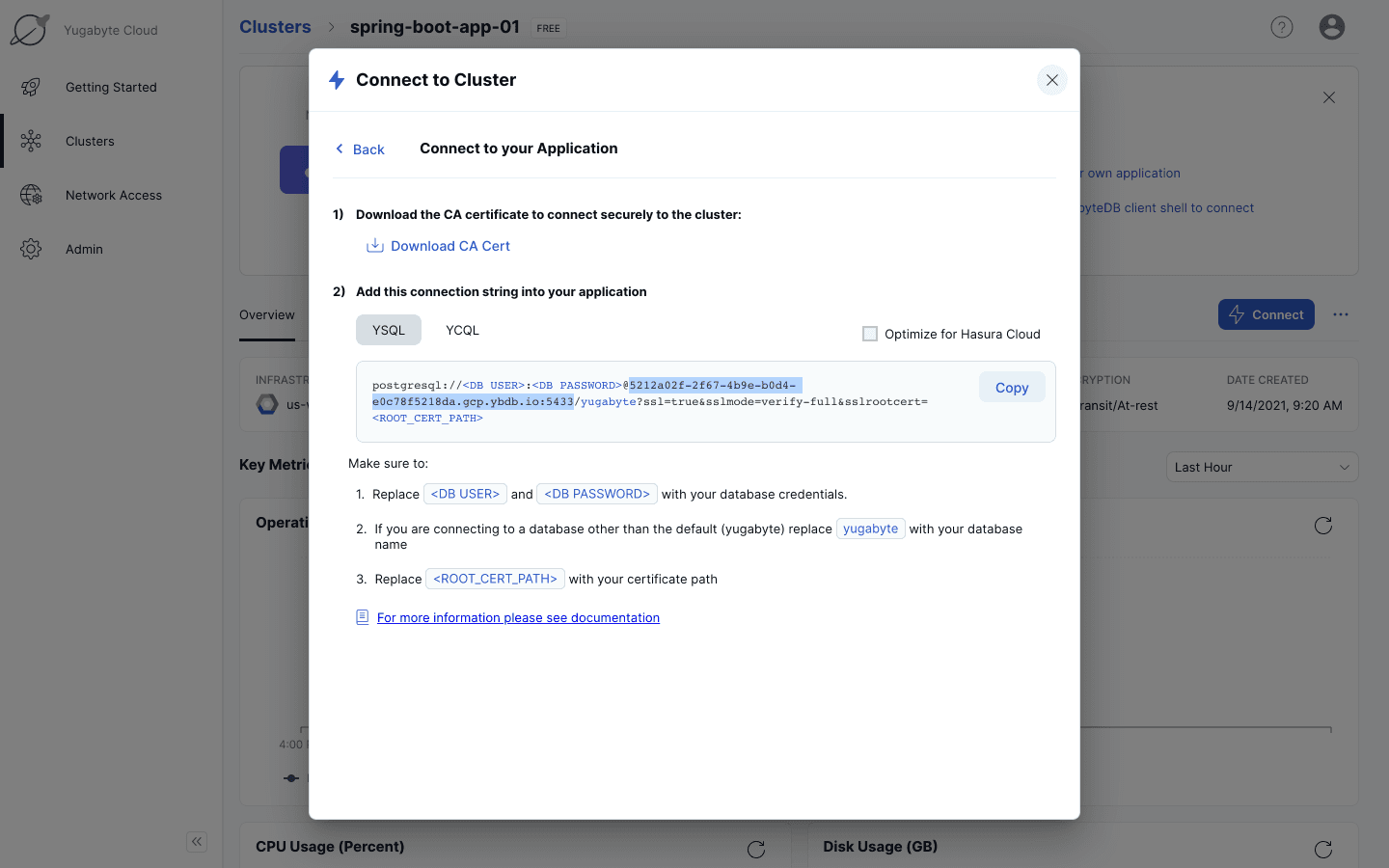
Click the Launch Cloud Shell button.
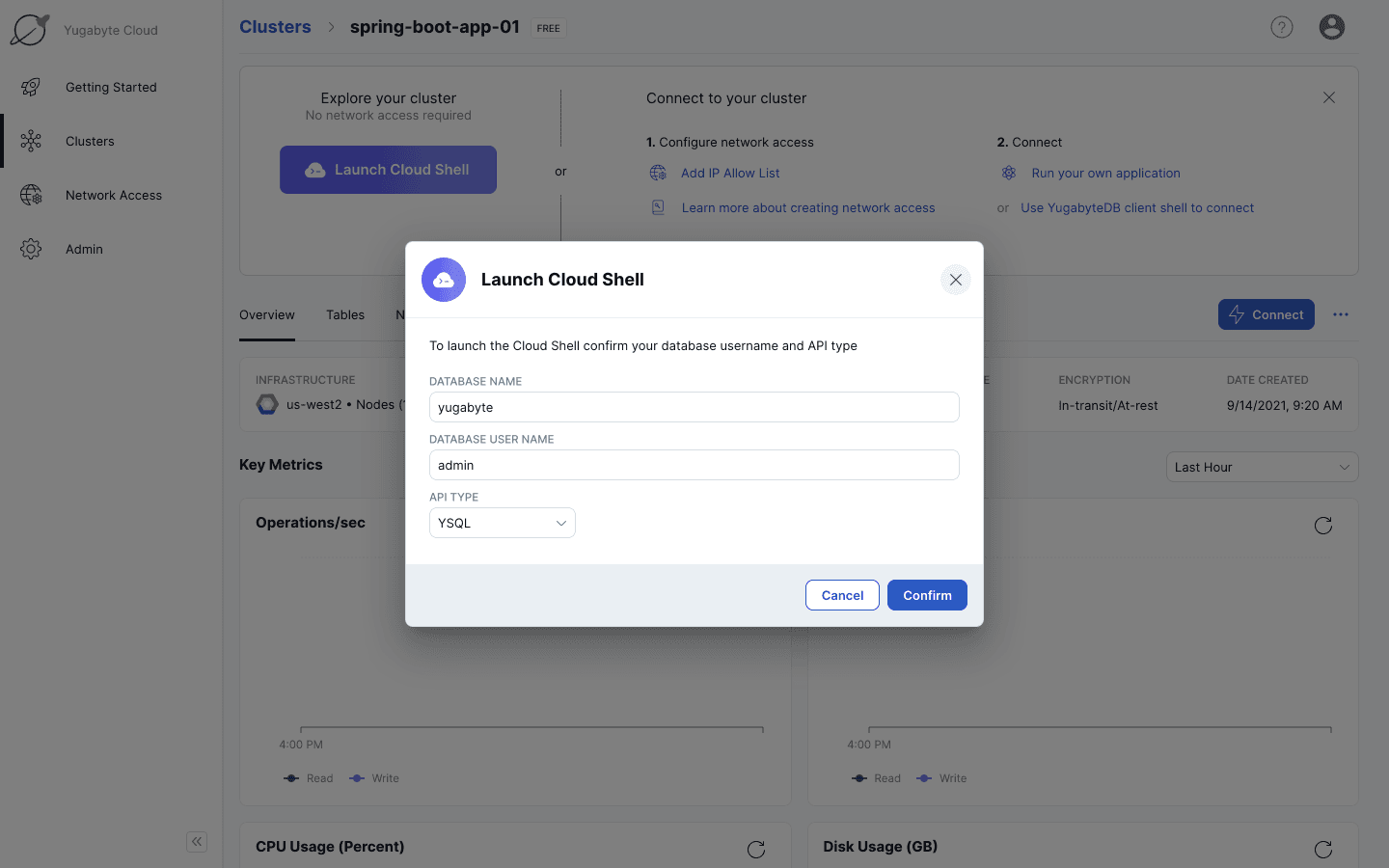
Enter the admin password you copied previously. After you enter the password, you will have a standard YSQL shell (exactly like a PSQL shell in PostgreSQL) that you can interact with from your browser.
Password for user admin: ysqlsh (11.2-YB-2.4.2.0-b0) SSL connection (protocol: TLSv1.2, cipher: ECDHE-RSA-AES256-GCM-SHA384, bits: 256, compression: off) Type "help" for help. yugabyte=#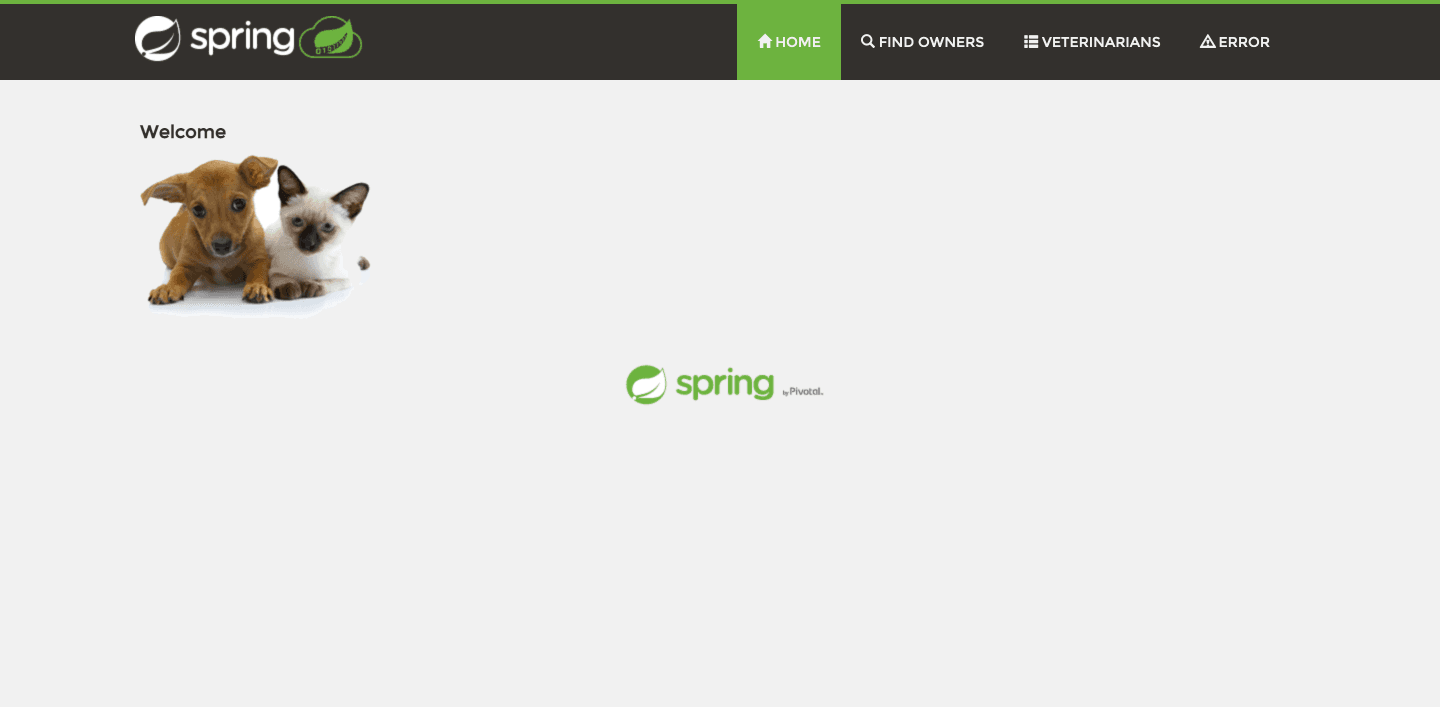
The PetClinic sample application is now connected to your Yugabyte Cloud cluster and running locally.
Containerize the Spring Boot PetClinic sample application
Start Docker on your computer and containerize your Spring Boot PetClinic sample application:
./mvnw spring-boot:build-image.Tag your image:
docker tag [image_id] spring-petclinic– you can find your image id by runningdocker image ls.Run your image as a container in Docker to make sure it’s working correctly:
docker run -d --name=spring-petclinic -p 8080:8080 -e JAVA_OPTS="-Dspring.profiles.active=yugabytedb -Dspring.datasource.url=jdbc:postgresql://[host]:[port]/petclinic?load-balance=true -Dspring.datasource.initialization-mode=never" spring-petclinic.a. Go to http://localhost:8080. The PetClinic sample application should be available.
The PetClinic sample application is now connected to your Yugabyte Cloud cluster and running locally on Docker.
Start minikube
Start Docker (or another minkube-compatible container/VM manager) on your computer.
Open terminal and start minikube:
minikube start😄 minikube v1.22.0 on Darwin 11.5.1 (arm64) ✨ Automatically selected the docker driver 👍 Starting control plane node minikube in cluster minikube 🚜 Pulling base image ... 💾 Downloading Kubernetes v1.21.2 preload ... > gcr.io/k8s-minikube/kicbase...: 326.19 MiB / 326.19 MiB 100.00% 10.82 Mi > preloaded-images-k8s-v11-v1...: 522.45 MiB / 522.45 MiB 100.00% 15.90 Mi 🔥 Creating docker container (CPUs=2, Memory=4000MB) ... 🐳 Preparing Kubernetes v1.21.2 on Docker 20.10.7 ... ▪ Generating certificates and keys ... ▪ Booting up control plane ... ▪ Configuring RBAC rules ... 🔎 Verifying Kubernetes components... ▪ Using image gcr.io/k8s-minikube/storage-provisioner:v5 🌟 Enabled addons: storage-provisioner, default-storageclass 🏄 Done! kubectl is now configured to use "minikube" cluster and "default" namespace by defaultOpen a 2nd terminal and run:
minikube dashboard🔌 Enabling dashboard ... ▪ Using image kubernetesui/dashboard:v2.1.0 ▪ Using image kubernetesui/metrics-scraper:v1.0.4 🤔 Verifying dashboard health ... 🚀 Launching proxy ... 🤔 Verifying proxy health ... 🎉 Opening http://127.0.0.1:51726/api/v1/namespaces/kubernetes-dashboard/services/http:kubernetes-dashboard:/proxy/ in your default browser...
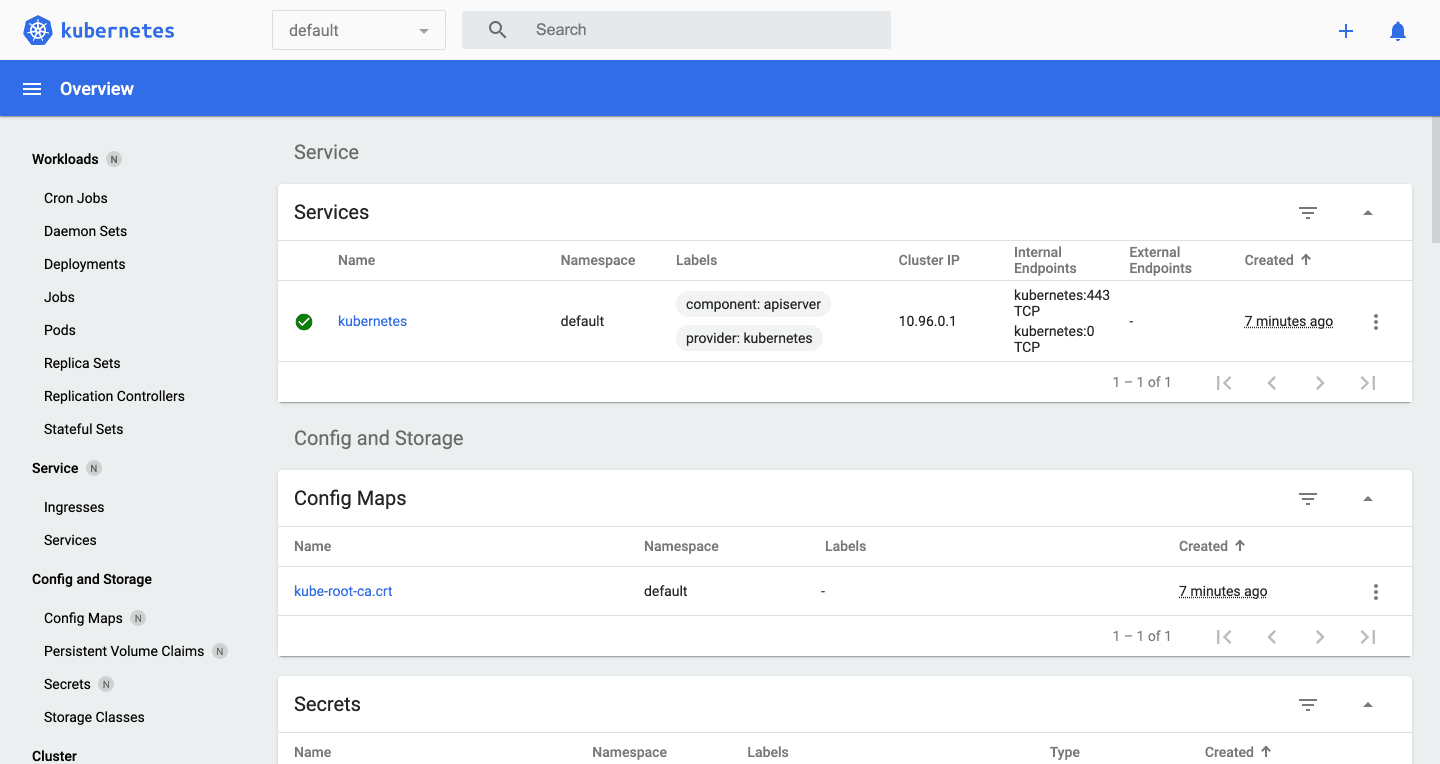
Deploy the Spring Boot PetClinic sample application image to minikube
In your 1st terminal, point your shell to minikube’s Docker daemon — This will make it so that Docker and kubectl will use your minikube container registry instead of Docker’s container registry
Run:minikube docker-env.export DOCKER_TLS_VERIFY="1" export DOCKER_HOST="tcp://127.0.0.1:58018" export DOCKER_CERT_PATH="/Users/gavinjohnson/.minikube/certs" export MINIKUBE_ACTIVE_DOCKERD="minikube" # To point your shell to minikube's docker-daemon, run: # eval $(minikube -p minikube docker-env)Run:
eval $(minikube -p minikube docker-env)— last line in output above.Build your image again:
./mvnw spring-boot:build-image.Tag your image again:
docker tag [image_id] spring-petclinic– you can find your image id by runningdocker image ls.Create a new file named
manifest-minikube.yml, enter the following contents, and save:apiVersion: v1 kind: Service metadata: name: spring-petclinic labels: run: spring-petclinic spec: selector: app: spring-petclinic ports: - protocol: TCP port: 8080 targetPort: 8080 type: LoadBalancer --- apiVersion: apps/v1 kind: Deployment metadata: name: spring-petclinic labels: app: spring-petclinic spec: replicas: 2 selector: matchLabels: app: spring-petclinic template: metadata: labels: app: spring-petclinic spec: containers: - name: spring-petclinic image: spring-petclinic imagePullPolicy: Never ports: - containerPort: 8080 env: - name: JAVA_OPTS value: "-Dspring.profiles.active=yugabytedb -Dspring.datasource.url=jdbc:postgresql://[host]:[port]/petclinic?load-balance=true -Dspring.datasource.initialization-mode=never"Create the Service and Deployment in minikube:
kubectl create -f manifest-minikube.yml.$ kubectl create -f manifest-minikube.yml service/spring-petclinic created deployment.apps/spring-petclinic createdOpen a 3rd terminal and externally expose your load balancer:
minikube tunnel$ minikube tunnel 🏃 Starting tunnel for service spring-petclinic.Wait for your application to come online (3 minutes or more for me).
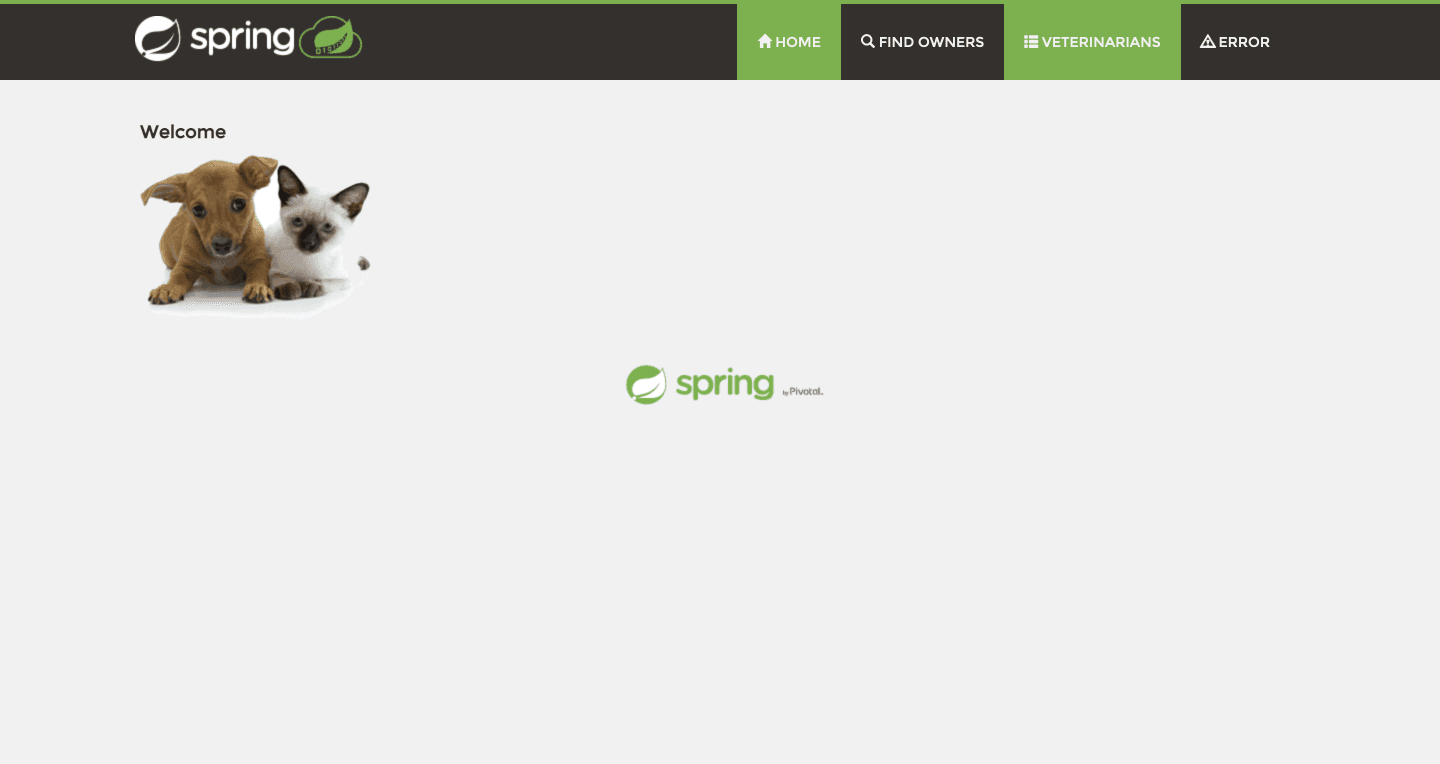
The PetClinic sample application is now connected to your Yugabyte Cloud cluster and running on Kubernetes locally on minikube.
Note:
If all else fails:
kubectl delete -f manifest-minikube.ymlminikube stopminikube delete --all
What’s Next?
Give Yugabyte Cloud a try by signing up for a free tier account in a couple of minutes. Got questions? Feel free to ask them in our YugabyteDB community Slack channel.